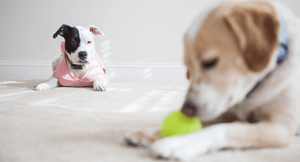introducing a new dog to a jealous dog

Here are some tips for introducing a new dog to a jealous dog:
Choose the right dog
Before introducing a new dog, consider the personality and temperament of your current dog and make sure the new dog is compatible.
Meet on neutral ground
A public space like a park or tennis court can help avoid territorial behavior. You can ask a friend or family member to bring the new dog on a leash while you have your current dog on a leash as well.
Start slowly
Begin with parallel walking on a leash at a distance so the dogs can see each other but not touch.
Watch body language
If either dog growls or snarls, they might be trying to say they want to be left alone. You can also step in if playtime gets too rough.
Create a routine
Establishing a routine for the first few weeks can help ensure a smooth transition for the new dog.
Use a dog gate
When the new dog comes home, you can use a tall, durable gate to separate them from your other pets. You can observe how they interact through the gate and reward positive behavior with treats.
Bringing Together Adult Dogs
Introducing adult dogs to each other can be significantly more difficult than adding a new puppy to the group.
The reason for this is that by the time dogs become adults, they have already developed their personality traits, which makes it challenging to teach them new behaviors, including sharing their personal space with a new companion. As noted earlier, the main concern is that your adult dog may not accept the new dog into the pack. This reluctance largely stems from the established pecking order within the group. Dogs have an innate way of determining their hierarchy, and introducing a new dominant dog might create significant tension.
To put it differently, if your dream is to adopt an adult dog in need of a loving home, don’t lose hope! By staying persistent and using effective de-escalation techniques, you can successfully handle the introduction process.
So, Why Do Resident Dogs Get Jealous?
Having only one dog at home is similar to having an only child, who faces unique social challenges. Your current dog has likely become accustomed to being the only pet and enjoys all the attention, affection, and treats. It’s natural for dogs, like people, to enjoy being the center of attention. Adjusting to sharing can be difficult.
Additionally, some dogs may show signs of jealousy because their breed isn’t naturally social. For instance, breeds such as the Akita, Bullmastiff, and Chow Chow were traditionally bred to work alone and are not typically social. Introducing such breeds to another dog, especially an adult, can be challenging. Therefore, before adopting another adult dog, ensure that your current dog’s breed is compatible with the new one.
You can usually tell if your dog will get along with a new friend by observing its body language. Pay attention to how your dog behaves around other dogs at the dog park or during walks.
Even small acts of aggression could potentially indicate more significant problems in the future.
Prepare Your Resident Dog
To facilitate a seamless introduction, invest the necessary time to mentally and emotionally prepare your dog for the new member of your family.
Ensure he comprehends the idea of sharing, which applies to his toys, bed, and even food. It’s crucial that your dog also learns to share your attention. If you have kids or a partner, teach your dog to be at ease when you spend time together with others around.
One method to assist your dog in getting used to sharing is to set up playdates with other dogs. The more exposure he has to social environments within a pack, the simpler it will be for him to adjust to a new family member at home. A dog’s jealousy is frequently linked to its belongings, such as toys and personal space. Instead of removing these items, teach your dog to share them with others for brief moments.
Devoting time to training your dog is one of the most worthwhile investments you can make, regardless of its age or breed.
Introduce on neutral territory
The best way to introduce dogs to each other is on neutral ground, preferably outdoors. Each dog should be on a leash, walked separately, with each handler carrying a bag of highly desirable treats broken into small pieces. Initially, walk the dogs at a distance where they can see each other without becoming too agitated.
If the dogs display no negative behaviors, reward them with treats for simply noticing each other. For instance, when the dog you are walking glances at the other dog, you can say “Good boy!” in a cheerful, friendly tone and offer a treat. Repeat this process frequently.
Pay attention to each dog’s body language
Pay close attention to body language that shows a defensive or cautious reaction, such as raised hackles, exposed teeth, growling, walking with stiff legs, or a long stare. If you notice any of these signs, whether the dogs are far apart or close together, promptly and calmly divert their attention by engaging them in another activity. If the dogs appear calm and at ease, you can decrease the distance between them. Additionally, reward the dogs with treats whenever they look at each other in a relaxed way.
Let the dogs determine the pace of the introduction
By the middle of the walk, the dogs might simply want to play together. It could also be that they need more time to feel at ease walking next to each other. The key is to proceed with this introduction gradually. The more patient you are, the higher your chances of success. Avoid compelling the dogs to engage with one another.
After the dogs can see each other up close, let one dog walk behind the other and then switch their positions. If both dogs stay relaxed, have them walk next to each other. Finally, let them interact while being closely watched. If either dog shows signs of stress or agitation, slow down the introduction process.
Monitor closely in the home
When initially bringing the dogs into the home, use a strong, tall baby gate to keep them apart. Watch how they behave towards each other through the gate. Encourage good behavior by giving the dogs high-value treats for their positive interactions.
Ensure that there are no toys, food, or treats scattered around the house that might provoke a conflict between the dogs. Additionally, stay alert to scenarios that might incite tension, such as when the dogs become excessively excited. Supervise the dogs closely when they are together, providing treats as positive reinforcement, until you are completely certain that they are at ease and safe with each other.
If you need assistance with introductions that aren’t going smoothly, please reach out to a professional dog trainer or animal behaviorist.
Greetings from the Petworled website management, we wish you success and see you in another article on our website.















